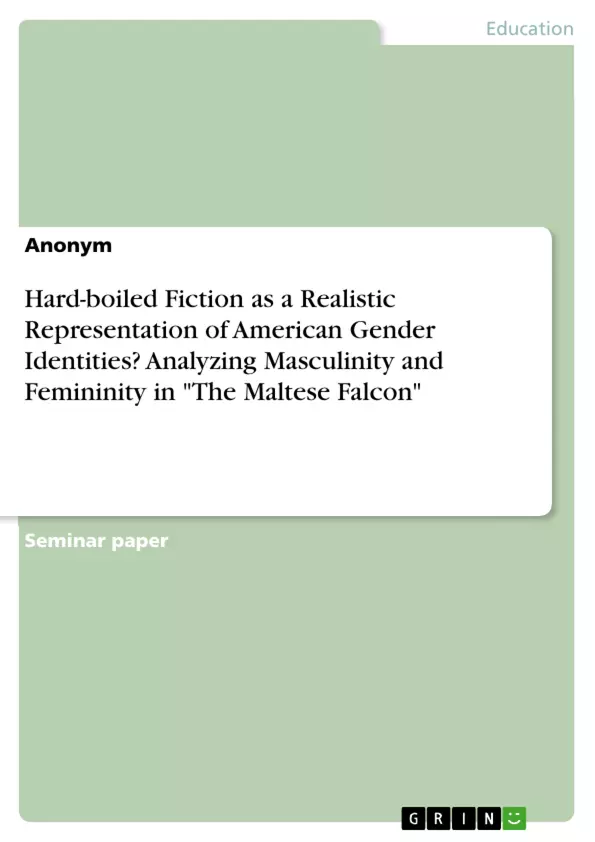In this term paper, I am going to argue that the reason for the gender conflict as well as the gender development in hard-boiled detective fiction can be found in the historical background and historical incidents of which the United States suffered during the Twenties. Further, I will support Seesslen’s claim that, after World War I, there was the public’s desire for a more honest and harsh view of America which is fulfilled by the post-war realism used in hard-boiled fiction.
For this, I will try to outline the realism in Dashiell Hammett’s "The Maltese Falcon" (1930) as a representation and/or critique of the United States in the 1920s. This particular novel is used because it can be seen as representative for many other hard-boiled fictions and the hard-boiled genre in general as Dashiell Hammett’s work redefined crime fiction. His stories mark an obvious shift from the classical detective story in which the detective is the main crime solver in middle-class suburban places, to an urban space in the United States where organized crime, gangsters and corruption pervade the city.
The characters involved in "The Maltese Falcon" will help to draw a certain connection between the historical development of the United States and the development of men and women in hard-boiled fiction. For that reason, in chapter 2, I will try to define the hard-boiled genre and in which way its plot structure and themes are shaped by the historical events and social issues of that time.
In chapter 3, I will present the two archetypal characters, the Femme fatale and the tough guy, in hard-boiled fiction. Because both of them can be found in "The Maltese Falcon", I will use this novel to analyse masculinity, or more precisely, the protagonist Sam Spade, and femininity, mainly Brigid O’Shaughnessy, in chapter 4 and 5.
By means of the conclusion in chapter 6 I will summarize the main results in order to support my thesis that the hard-boiled fictions’ plot, especially the gender identities, mirror historical incidents and social developments the United States underwent during 1920 onward.
In addition, I will put the insights on femininity and masculinity in hard-boiled detective fictions in a broader context concerning the film industry and the hard-boiled fiction’s impact on following genres, just like Film noir.
Inhaltsverzeichnis (Table of Contents)
- INTRODUCTION
- THE HARD-BOILED GENRE
- ARCHETYPAL CHARACTERS IN HARDBOILED FICTION
- TOUGH GUY
- FEMME FATALE
- MASCULINITY IN THE MALTESE FALCON
- FEMININITY IN THE MALTESE FALCON
Zielsetzung und Themenschwerpunkte (Objectives and Key Themes)
This term paper aims to explore the evolution of gender identities in hard-boiled detective fiction, specifically focusing on the representation of masculinity and femininity in Dashiell Hammett's The Maltese Falcon (1930). The paper will argue that the shift in gender roles depicted in hard-boiled fiction during the 1920s was influenced by historical events and social developments in the United States, particularly the aftermath of World War I.
- The influence of historical events and social changes on the development of hard-boiled detective fiction.
- The representation of masculinity and femininity in hard-boiled fiction, particularly in The Maltese Falcon.
- The role of archetypal characters, the “tough guy” and the “Femme fatale”, in shaping gender identities in hard-boiled fiction.
- The connection between the collapse of appearance and reality in the post-war era and the portrayal of gender roles in hard-boiled fiction.
- The impact of hard-boiled fiction on subsequent genres, such as film noir.
Zusammenfassung der Kapitel (Chapter Summaries)
Chapter 2 will provide a definition of the hard-boiled genre, examining how its plot structure and themes reflect the historical events and social issues of the time. The chapter will explore how the genre emerged as a response to the rapid changes in American society during the 1920s, including the growth of industrialization and the rise of organized crime.
Chapter 3 will introduce the two archetypal characters, the “tough guy” and the “Femme fatale”, in hard-boiled fiction. The chapter will discuss how these characters, often presented in a stereotypical manner, reflect societal anxieties and desires related to gender roles.
Chapters 4 and 5 will analyze the representation of masculinity and femininity in The Maltese Falcon, focusing on the protagonist, Sam Spade, and the character of Brigid O’Shaughnessy, respectively. These analyses will examine how the novel utilizes these characters to explore the complexities of gender identities in the post-war era.
Schlüsselwörter (Keywords)
The key themes and concepts explored in this paper include: hard-boiled fiction, gender identities, masculinity, femininity, archetypal characters, The Maltese Falcon, Dashiell Hammett, post-war America, social change, historical context, realism, film noir.
- Arbeit zitieren
- Anonym (Autor:in), 2017, Hard-boiled Fiction as a Realistic Representation of American Gender Identities? Analyzing Masculinity and Femininity in "The Maltese Falcon", München, GRIN Verlag, https://www.hausarbeiten.de/document/1043521


